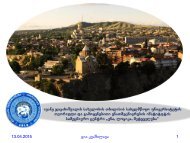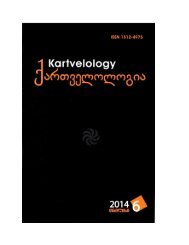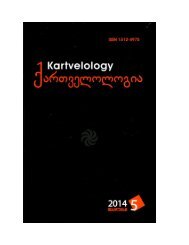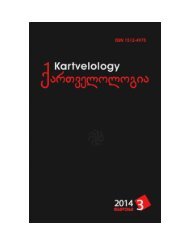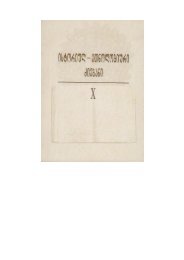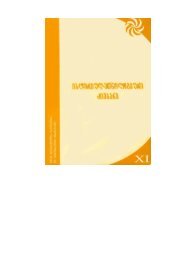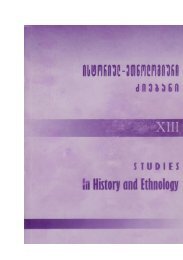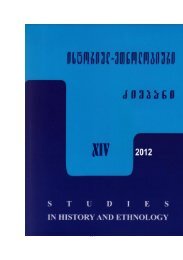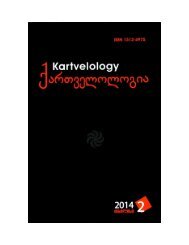Kvashilava, Gia, 2010. On Reading Pictorial Signs of the Phaistos Disk and Related Scripts (2). Rosette (in Georgian and English)
This study concerns the graphic character, symbolic meanings, typological parallels, commentaries and reading of the Phaistos Disk pictorial sign PHD38.
This study concerns the graphic character, symbolic meanings, typological parallels, commentaries and reading of the Phaistos Disk pictorial sign PHD38.
You also want an ePaper? Increase the reach of your titles
YUMPU automatically turns print PDFs into web optimized ePapers that Google loves.
Greek – Aea is <strong>the</strong> spr<strong>in</strong>g nymph loved by <strong>the</strong><br />
Colchian river god Phasis; <strong>the</strong> isl<strong>and</strong> Aea <strong>in</strong> Colchis (Flaccus<br />
V, 426; Smith 1869, I, 22);<br />
Greek , genit. case 1 (Homer, Iliad VIII, 1; Apollonius<br />
<strong>of</strong> Rhodes I, 580; Owen 1851, 147; Merkel 1854, 30, 580; Urushadze<br />
1970, 66, 580), accord<strong>in</strong>g to Greek sources (Kaukhchishvili<br />
1952, IV, II, 315; Urushadze 1948, 224 96 ; 1964,<br />
479) or Dorian , 2 Ionian – means ‟l<strong>and</strong>‟, ‟<strong>the</strong> earth‟<br />
(Theopompi 340; Müllerus 1841, 332, 340; Perr<strong>in</strong>, Seymour<br />
1897, Vocabulary, 3; Smith 1870, II, 195; Weisman 1899, 2006,<br />
27, 261, 270, 298; MPW 1991, I, 300; Urushadze 1964, 319;<br />
Gordeziani 1999, 53; 2007, III, 473);<br />
Greek / – Gaea/Gea/Ge is <strong>the</strong> goddess <strong>of</strong> <strong>the</strong> Earth;<br />
greatly worshipped by Colchis (Apollonius <strong>of</strong> Rhodes III, 714-717;<br />
Schol. ad. Apoll. Rhod. III, 714; Merkel 1854, 169-170, 714-717;<br />
467, 714; Coleridge 1889, 123-124; Smith 1870, II, 195; Urushadze<br />
1964, 514; 1970, 350 15 , 364; Lordkipanidze 1986, 128 8 );<br />
Mycenaean Greek Aiwa – [a 3 -wa] KN C 973 (Ventris,<br />
Chadwick 1973, 537; DMic 2 ; Isebaert 2005, 168) 3 that is read as<br />
, Aia – Aea, a bull’s nickname (Tsymburskij 2005, 309);<br />
Mycenaean Greek Aiwajā – [a 3 -wa-ja] PY En 74.22<br />
(S74-H1/S.1), [a 3 -wa- <strong>the</strong> rest is unreadable] PY Eo 160.2<br />
(H41/S.41) (Ventris, Chadwick 1973, 537; DMic 2 ; Isebaert 2005,<br />
168), that S. Hiller (1991, 214) <strong>and</strong> V. Tsymburskij (2005, 308)<br />
1 . Also see: Homer, Iliad II, 162, 178; III, 243-244; IV, 172; VIII, 1; IX,<br />
506; XI, 817; XV, 740; XVI, 539; XXIII, 327, 742; XXIV, 695; Odyssey I,<br />
41, 75, 203; IV, 262, 521; X, 236, 472; XI, 301; XVIII, 145; XIX, 301; XXI,<br />
62-63; XXIII, 353; XXIV, 290; Tsymburskij 2005, 309-311 <strong>and</strong> ff.<br />
2 . Comp. M<strong>in</strong>gralian [ga] – a hill, a hillock (Sharashenidze 1983, 40-<br />
41; Kajaia 2001, I, 277).<br />
3 . The number<strong>in</strong>g <strong>of</strong> clay tablets <strong>and</strong> abbreviations are given accord<strong>in</strong>g E. L.<br />
Bennett <strong>and</strong> GORILA: a 3 = ai, Cn = livestock, HM = Heraklion Museum, HT =<br />
Hagia Triada, KH = Chania, KN = Knossos, MY = Mycenae, PY = Pylos, Sd =<br />
chariots <strong>and</strong> armor, SY = Syme, TH = Thebes, Wc = roundels, Za = stone vessels.<br />
308




